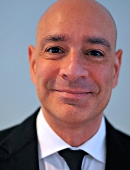My laboratory is focused on developing and using noninvasive imaging methods that allow the early detection, prevention, and treatment of cardiovascular disease. Despite considerable therapeutic advances over the past 50 years, cardiovascular disease is the leading cause of death worldwide. This is mainly a result of the increasing prevalence of atherosclerosis, owing to the ageing population, the improved survival of patients with atherosclerotic cardiovascular disease and, above all, the widespread under-recognition and undertreatment of individuals with risk factors for atherosclerosis. Atherosclerosis is characterized by the thickening of the arterial wall to form an atherosclerotic plaque, a process in which cholesterol deposition, inflammation, extracellular-matrix formation and thrombosis have important roles (see Sanz and Fayad Nature 2008; 45:953-957). Symptoms occur late in the course of disease and are usually caused by the narrowing of the lumen of the artery, which can happen gradually (as a result of progressive plaque growth) or suddenly (as a result of plaque rupture and, subsequently, thrombosis). The resultant decrease in blood supply can affect almost any organ, although coronary heart disease and stroke are the most common consequences.
Traditionally, diagnosis of atherosclerosis was possible only at advanced stages of disease, either by directly revealing the narrowing of the arterial lumen (stenosis) or by evaluating the effect of arterial stenosis on organ perfusion. We are developing and using, new imaging approaches that allow the assessment not only of the morphology of blood vessels but also of the composition of the vessel walls, enabling atherosclerosis-associated abnormalities in the arteries (including the coronary arteries) to be observed, down to the cellular and molecular level in some cases. Some of these approaches are now in clinical use or are being tested in clinical trials, whereas others are better suited to basic (preclinical) and translational research.
Our current activities are focused on:
Imaging Acquisition and Analysis Methods: Development of novel multimodality cardiovascular imaging and analysis techniques using macro- and micro- Cardiovascular Magnetic Resonance (CMR), computed tomography (CT), positron emission tomography (PET), and optical imaging.
Early Detection and Outcomes Prediction: Use of in vivo noninvasive multimodality imaging methods for the early detection of atherosclerosis in humans and for cardiovascular events and outcomes prediction.
Clinical Trials and Drug Development: Use in vivo noninvasive multimodality imaging methods in clinical trials for the development and testing of novel therapeutics to treat atherosclerosis.
Molecular Imaging: Development and use of novel multimodality imaging nanoparticulate systems to monitor fundamental cellular/molecular events in living subjects including patients.
Drug Delivery: Development and use of novel targeted drug delivery nanoparticulate systems to improve the treatment of atherosclerosis in living subjects including patients.
